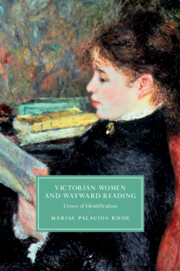Book contents
- Victorian Women and Wayward Reading
- Cambridge Studies in Nineteenth-Century Literature and Culture
- Victorian Women and Wayward Reading
- Copyright page
- Dedication
- Contents
- Figures
- Acknowledgments
- Introduction
- Chapter 1 Masculine Identification and Marital Dissolution
- Chapter 2 Novels without Heroines: Sensation and Elective Identification
- Chapter 3 Character Invasion and the Victorian Actress
- Chapter 4 Antipathetic Telepathy: Female Mediums and Reading the Enemy
- Chapter 5 “The Valley of the Shadow of Books”: The Morbidity of Female Detachment
- Chapter 6 The New Crisis: Can We Teach Identification?
- Notes
- Works Cited
- Index
- Cambridge Studies in Nineteenth-Century Literature and Culture
Chapter 6 - The New Crisis: Can We Teach Identification?
Published online by Cambridge University Press: 30 October 2020
- Victorian Women and Wayward Reading
- Cambridge Studies in Nineteenth-Century Literature and Culture
- Victorian Women and Wayward Reading
- Copyright page
- Dedication
- Contents
- Figures
- Acknowledgments
- Introduction
- Chapter 1 Masculine Identification and Marital Dissolution
- Chapter 2 Novels without Heroines: Sensation and Elective Identification
- Chapter 3 Character Invasion and the Victorian Actress
- Chapter 4 Antipathetic Telepathy: Female Mediums and Reading the Enemy
- Chapter 5 “The Valley of the Shadow of Books”: The Morbidity of Female Detachment
- Chapter 6 The New Crisis: Can We Teach Identification?
- Notes
- Works Cited
- Index
- Cambridge Studies in Nineteenth-Century Literature and Culture
Summary
The final chapter moves beyond historical examples of wayward reading to current pedagogical praxis. It examines recent psychological studies of how modern readers self-report their identificatory experiences, and how interpretation of these experiences remains conditioned by Victorian rhetoric and assumptions. The discourse of anxiety that surrounded women’s reading in the nineteenth century has shifted direction in the late twentieth and twenty-first centuries. Now cultural consternation is leveled at boys’ deficiency in reading engagement. The chapter closes with examples and suggestions of ways in which we might counter these embedded expectations of identification and lack thereof, especially by surmounting essentialist gender stereotypes. Considering the implications of current research on the cognitive dynamics of reading, the chapter argues that students can learn to interrogate their supposedly “natural” or spontaneous identification with texts or resistance to them. Pedagogical techniques are recommended that prompt readers to control and shift their identifications in order to navigate their own way through a text. Although no longer “wayward” outside of the Victorian context, these techniques of identification equip students for the consciously active mode of reading to which women were, and boys now are, thought to be essentially averse.
- Type
- Chapter
- Information
- Victorian Women and Wayward ReadingCrises of Identification, pp. 146 - 165Publisher: Cambridge University PressPrint publication year: 2020



